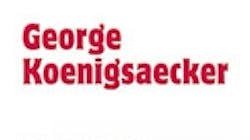Getting Lean Right: Lessons Learned From a Lifetime of Lean
George Koenigsaecker wished someone had told him what he's telling others. While he was responsible for starting eleven companies on their lean journeys, he explains his lessons learned were the "results of multiple trail-and-error experiments, where I implemented a variety of leadership practices." Now he wants to save other manufacturing executives some valuable time. His book, Leading the Lean Enterprise Transformation is the missing link. He offers this book as a guide for leaders to not only build, but more importantly, to maintain lean efforts.
In the book he examines the tools of the lean trade and explores some of the lean implementations that he was involved in during his work with Deere & Company, Rockwell International, Jake Brake (Danaher) and Hon.
The secret to his success, as all of these companies are still on their lean journeys many years later, is the development of a culture. "The true power," he told me during an interview, "is to create a sustainable culture. Leaders need to be humble and be good students. It's a lifelong journey."
One of the keys to sustainability is learning what you need to measure. Using Toyota's True North Metrics, he says, good things happen. The four metrics are:
- Quality improvement
- Delivery/lead time/flow improvement
- Cost/Productivity Improvement
- Human development
Aside from detailed explanations of value stream analysis, Koenigsaecker provides tactical organizational practices. He discusses the n/10 rule which means that the "pace of overall improvement is roughly proportional to the pace of events that you implement in support of your value stream improvement plans." As an example during his leadership at HON he targeted and met improvement rates that included a 15% enterprise productivity growth, a 50% reduction in lead times, a 20% reduction in defect rates and a 20% accident rate reduction.
His advice for long term improvement includes:
- Establish a regular pace of process improvement activity at a level that seems high to the folks who are not yet part of an improvement culture.
- Build a dedicated support group of your best folks, who will also be your future sensei.
- Be thoughtful about the makeup of each improvement team and its goals.
- Develop a robust redeployment process that provides the human resources necessary to support lean efforts and the productivity gains to improve business results.
It is however the task of building a lean culture that is the most difficult part of any lean journey, Koenigsaecker says. "But it also the most powerful and the most personally rewarding part. Koenigsaecker quotes Kosuke Ikebuchi of Toyota who said that "Westerners put too much emphasis on tools and technology, and not enough on philosophy and leadership behaviors."
George is currently president of Lean Investments, LLC. His book Leading the Lean Enterprise Transformation is available at Productivity Press http://www.crcpress.com/product/isbn/9781563273827
To read his profile in the IW Hall of Fame click here
